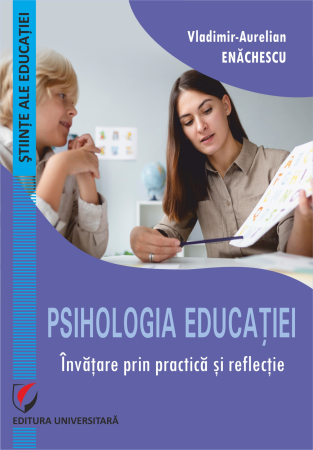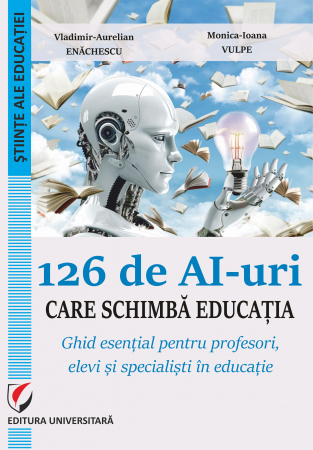Manuscript proposals: [email protected] / 0745 204 115 //// Tracking orders Individuals / Sales: 0745 200 357 / Orders Legal entities: 0721 722 783
Publisher: Editura Universitară
Author: Cristina Dumitru Tabacaru
Edition: I
Pages: 134
Publisher year: 2024
ISBN: 978-606-28-1863-0
DOI: 10.5682/9786062818630
Product Code:
9786062818630
Do you need help?
0745 200 357
- Description
- Download (1)
- Authors
- Content
- More details
- Reviews (0)
Psychopedagogical intervention for children with behavioral problems is essential in the professional training of teachers, because effective learning cannot take place in an environment disturbed by problematic behaviors. Equipping teachers with techniques to manage and reduce these behaviors will significantly contribute to improving the learning process. The purpose of this book is to encourage teachers to pay more attention to the dynamics of school learning and the problematic aspects of school life. The book is aimed at teachers, educational researchers and all those whose daily work is related to the educational process and what happens in classrooms.
-
Psychopedagogical intervention programs for children with behavioral problems
Download
CRISTINA DUMITRU TABACARU is a doctor of educational sciences, university lecturer in the Department of Education of the National University of Science and Technology POLITEHNICA Bucharest, Pitesti University Center, with over 15 years of experience in the field of special education and inclusive education. She is also the coordinator of several Erasmus projects on inclusive education and specific learning disorders.
INTRODUCTION / 7
PART I
UNDERSTANDING PROBLEM BEHAVIORS IN THE SCHOOL ENVIRONMENT / 11
I. WHAT ARE BEHAVIORAL PROBLEMS? / 13
I.1. Characteristics of problematic behaviors / 13
I.2. Minor and major behavior problems / 22
I.3. The main problematic behaviors in the educational environment / 24
II. PREVENTION AND MANAGEMENT OF BEHAVIORAL PROBLEMS / 27
II.1. The traditional approach in managing problematic behaviors / 27
II.2. The causes of problematic behaviors / 32
II.3. Do we or do we not sanction major challenging behaviours? / 35
II.4. Initiation of behavioral intervention programs / 38
III. CLASSROOM MANAGEMENT AND BUILDING A COMMON APPROACH TO PROBLEM BEHAVIORS / 42
III.1. The advantages of class management / 42
III.2. Organization of the physical space of the school and the classroom to reduce disruptive behaviors / 51
III.3. Procedures and routines in classroom management / 53
III.4. The institutional approach to problematic behaviors / 64
PART II
BEHAVIORAL INTERVENTION STRATEGIES / 69
I. BEHAVIORAL LEARNING STRATEGIES / 71
I.1. Reward / 71
I.2. Behavioral teaching / 81
I.3. Recommendations for effective management of problematic behaviors for teachers / 86
II. INDIRECT AND DIRECT STRATEGIES FOR MANAGING PROBLEM BEHAVIORS / 90
II.1. Indirect strategies for managing problematic behaviors / 90
II.2. Direct strategies for managing problematic behaviors / 95
II.3. Low intensity strategies / 97
II.4. Rules for changing problematic behaviors of children / 100
III. SUPPORT TOOLS IN MANAGING PROBLEM BEHAVIORS IN THE CLASSROOM / 102
III.1. Self-assessment of the capacities to manage problematic behaviors in the classroom / 102
III.2. Functional behavior analysis - tool for recording and analyzing problematic behaviors in the classroom / 105
III.3. Tools for self-monitoring of problematic behaviors / 110
PART III
MODELS OF APPROACHING SOME SPECIFIC PROBLEM BEHAVIORS OF STUDENTS / 115
I. How do we work with children who refuse to do their homework? / 115
II. How do we work with anxious students? / 116
III. How do we work with irritable children? / 118
IV. How to work with rude children who have aggressive language / 121
V. How do we work with children with ADHD? / 123
BIBLIOGRAPHY / 128
PART I
UNDERSTANDING PROBLEM BEHAVIORS IN THE SCHOOL ENVIRONMENT / 11
I. WHAT ARE BEHAVIORAL PROBLEMS? / 13
I.1. Characteristics of problematic behaviors / 13
I.2. Minor and major behavior problems / 22
I.3. The main problematic behaviors in the educational environment / 24
II. PREVENTION AND MANAGEMENT OF BEHAVIORAL PROBLEMS / 27
II.1. The traditional approach in managing problematic behaviors / 27
II.2. The causes of problematic behaviors / 32
II.3. Do we or do we not sanction major challenging behaviours? / 35
II.4. Initiation of behavioral intervention programs / 38
III. CLASSROOM MANAGEMENT AND BUILDING A COMMON APPROACH TO PROBLEM BEHAVIORS / 42
III.1. The advantages of class management / 42
III.2. Organization of the physical space of the school and the classroom to reduce disruptive behaviors / 51
III.3. Procedures and routines in classroom management / 53
III.4. The institutional approach to problematic behaviors / 64
PART II
BEHAVIORAL INTERVENTION STRATEGIES / 69
I. BEHAVIORAL LEARNING STRATEGIES / 71
I.1. Reward / 71
I.2. Behavioral teaching / 81
I.3. Recommendations for effective management of problematic behaviors for teachers / 86
II. INDIRECT AND DIRECT STRATEGIES FOR MANAGING PROBLEM BEHAVIORS / 90
II.1. Indirect strategies for managing problematic behaviors / 90
II.2. Direct strategies for managing problematic behaviors / 95
II.3. Low intensity strategies / 97
II.4. Rules for changing problematic behaviors of children / 100
III. SUPPORT TOOLS IN MANAGING PROBLEM BEHAVIORS IN THE CLASSROOM / 102
III.1. Self-assessment of the capacities to manage problematic behaviors in the classroom / 102
III.2. Functional behavior analysis - tool for recording and analyzing problematic behaviors in the classroom / 105
III.3. Tools for self-monitoring of problematic behaviors / 110
PART III
MODELS OF APPROACHING SOME SPECIFIC PROBLEM BEHAVIORS OF STUDENTS / 115
I. How do we work with children who refuse to do their homework? / 115
II. How do we work with anxious students? / 116
III. How do we work with irritable children? / 118
IV. How to work with rude children who have aggressive language / 121
V. How do we work with children with ADHD? / 123
BIBLIOGRAPHY / 128
"Did I do the right thing by banning him from playing on the computer?", "Am I spending enough time with him?", "Was I demanding enough or should I be even tougher?", "Why is he protesting and not following the rules?" " Training and educating children has never been easy. We make decisions every day and often question our choices. However, there are studies and proven strategies that can make classroom work easier and help students adopt positive behaviors that support their learning. The challenges of the educational system are related to the constant changes in the environment, which influence the main actors, students and teachers. This dynamism imposes the need to adequately respond to all requests from the family, economic and social environment. The advantage of the school and its main role is to provide an organized and judiciously planned setting, managed by people with the necessary training to expose children, in a controlled manner, to various situations that they can learn to manage so that they can adapt effectively when they become adults.
School is a micro-society, where the social group expands, children being exposed to a varied range of social interactions, much more diverse than those in the family environment. For effective learning, this process must be mediated and facilitated by professionals, by well-trained teachers. As a living, dynamic system where teachers and students interact and develop, challenging behaviors are expected to be part of the school reality. Children go to school not only to learn academic knowledge, but also to acquire socially appropriate behaviors, to enrich their behavioral repertoire with positive role models. It is natural for a young child who does not have these behavior patterns to cry to signal difficulties or needs. As they grow, children learn more appropriate behaviors, such as using verbal language. Without learning effective ways of behaving, difficult behaviors can occur. This also happens in the classroom, where disruptive behaviors can be deviations from social norms or ineffective ways of expressing needs, when the child does not know other more appropriate ways of behaving or they are reinforced by the consequences that follow them.
In this context, the role of the teacher is to enrich the repertoire of social behaviors of children with positive models, so that they have the skills and competences necessary for positive relationships with others, expression and adaptation to the external environment. The teacher's attitude towards the disruptive behaviors that occur at school must be one of acceptance and transforming them into learning opportunities, in order to practice positive and socially appropriate behavioral patterns. Psychopedagogical intervention for children with behavioral problems is an essential field in the professional training of teachers, because effective learning cannot take place in an environment disturbed by problematic behaviors. Acquiring techniques to reduce these behaviors will contribute significantly to facilitating the learning process. Academic learning involves a set of skills such as active attention, concentration, sustaining effort, and delaying gratification. An effective education and achieving good results at school are not accidental, but result from rigorous planning, implementation of consistent learning activities, assessment and constant self-assessment.
When behavioral difficulties are added to this already complex process (fear, anxiety, disengagement, absences, reduced concentration, unpunctuality, lies, disrespect and severe problematic behaviors such as self-aggression, aggression, bullying, etc.), the challenges of the teaching staff increase exponentially. An effective classroom approach must involve managing and reducing these negative behaviors to create an environment conducive to learning. This book was designed as a response to the challenges teachers face in their work. In order to achieve the goal of forming independent, active and competent citizens in the labor market, teachers must overcome communication difficulties that occur in the classroom and that can reduce the effectiveness of learning, thus creating a positive climate.
The book aims to address behavioral difficulties by providing methods for defining and operationalizing them, mechanisms for monitoring problem behaviors, data collection tools, and ways to select appropriate strategies for managing challenging behaviors in the classroom. Readers will also discover a number of effective communication techniques that require appropriate skills but also sensitivity and understanding of students' needs. Ensuring optimal conditions for learning is not possible without developing programs to create a positive climate, where all those who need support (students, parents, teachers) can benefit from it. Adequate theoretical and practical training of future teachers and educators in managing problem behaviors is crucial.
The continuous expansion of the inclusive education system and the transition to the integrated education of children with special educational needs have changed the school population, putting teachers in front of new challenges. Behavioral difficulties occur frequently among children with disabilities, and they are more common among children with special educational needs than among typical children. It is therefore evident that teachers need knowledge and practice in techniques for managing disruptive behaviours, in providing alternatives to reduce them and in modeling positive and appropriate behaviours. In addition, teachers must have coping and conflict management strategies.
Preventing, managing and reducing behavioral difficulties is not at all simple. Although learning behavioral techniques can help solve the problem, variables such as the individuality of the student, environmental influences, diverse needs of the student, and the functions of the behaviors make the situation complex. Even experts in behavioral modeling and analysis cannot always identify the best strategy for correcting disruptive behavior. However, it is clear that a solution must be found, as behavioral difficulties can make interactions with others and, by implication, the learning process difficult. Our job as parents or teachers is to teach children positive patterns of behavior and healthy attitudes to relate to themselves and others. Disruptive behaviors such as biting, constant crying, lying, stealing, hitting, or continuous protesting make it less likely that others will want to interact with these children. After all, no one likes to be in an environment that triggers negative or unpleasant emotions.
So what is to be done? We certainly need to learn how to manage these problematic situations and how to shape or change our students' behaviors to make our lives (as parents or teachers) easier and at the same time help students to be more prepared and more engaged in the learning process. Identifying behaviors that disrupt the learning process, as well as preventing and managing them in a timely manner are essential for ensuring an effective educational process. The topics proposed for the study of this issue include the definition of problematic behaviors, the identification of those behaviors that negatively affect learning, their classification into minor and major behaviors, the functional analysis of disruptive behaviors, and the development of strategies based on empirical research to overcome them.
The book also provides recommendations for those who interact with children with behavioral problems, offering solutions for managing them and encouraging positive behaviors. Ways to develop personalized action plans for addressing and changing problem behaviors in the classroom are also suggested. The book presents the necessary steps to change a child's behavior and we hope that the reader will find specific ideas, recommendations and strategies to help them manage disruptive behaviors more effectively and help create a positive climate both at school and at home. Creating a safe, pleasant and friendly environment is an essential step on which further learning will be built.
School is a micro-society, where the social group expands, children being exposed to a varied range of social interactions, much more diverse than those in the family environment. For effective learning, this process must be mediated and facilitated by professionals, by well-trained teachers. As a living, dynamic system where teachers and students interact and develop, challenging behaviors are expected to be part of the school reality. Children go to school not only to learn academic knowledge, but also to acquire socially appropriate behaviors, to enrich their behavioral repertoire with positive role models. It is natural for a young child who does not have these behavior patterns to cry to signal difficulties or needs. As they grow, children learn more appropriate behaviors, such as using verbal language. Without learning effective ways of behaving, difficult behaviors can occur. This also happens in the classroom, where disruptive behaviors can be deviations from social norms or ineffective ways of expressing needs, when the child does not know other more appropriate ways of behaving or they are reinforced by the consequences that follow them.
In this context, the role of the teacher is to enrich the repertoire of social behaviors of children with positive models, so that they have the skills and competences necessary for positive relationships with others, expression and adaptation to the external environment. The teacher's attitude towards the disruptive behaviors that occur at school must be one of acceptance and transforming them into learning opportunities, in order to practice positive and socially appropriate behavioral patterns. Psychopedagogical intervention for children with behavioral problems is an essential field in the professional training of teachers, because effective learning cannot take place in an environment disturbed by problematic behaviors. Acquiring techniques to reduce these behaviors will contribute significantly to facilitating the learning process. Academic learning involves a set of skills such as active attention, concentration, sustaining effort, and delaying gratification. An effective education and achieving good results at school are not accidental, but result from rigorous planning, implementation of consistent learning activities, assessment and constant self-assessment.
When behavioral difficulties are added to this already complex process (fear, anxiety, disengagement, absences, reduced concentration, unpunctuality, lies, disrespect and severe problematic behaviors such as self-aggression, aggression, bullying, etc.), the challenges of the teaching staff increase exponentially. An effective classroom approach must involve managing and reducing these negative behaviors to create an environment conducive to learning. This book was designed as a response to the challenges teachers face in their work. In order to achieve the goal of forming independent, active and competent citizens in the labor market, teachers must overcome communication difficulties that occur in the classroom and that can reduce the effectiveness of learning, thus creating a positive climate.
The book aims to address behavioral difficulties by providing methods for defining and operationalizing them, mechanisms for monitoring problem behaviors, data collection tools, and ways to select appropriate strategies for managing challenging behaviors in the classroom. Readers will also discover a number of effective communication techniques that require appropriate skills but also sensitivity and understanding of students' needs. Ensuring optimal conditions for learning is not possible without developing programs to create a positive climate, where all those who need support (students, parents, teachers) can benefit from it. Adequate theoretical and practical training of future teachers and educators in managing problem behaviors is crucial.
The continuous expansion of the inclusive education system and the transition to the integrated education of children with special educational needs have changed the school population, putting teachers in front of new challenges. Behavioral difficulties occur frequently among children with disabilities, and they are more common among children with special educational needs than among typical children. It is therefore evident that teachers need knowledge and practice in techniques for managing disruptive behaviours, in providing alternatives to reduce them and in modeling positive and appropriate behaviours. In addition, teachers must have coping and conflict management strategies.
Preventing, managing and reducing behavioral difficulties is not at all simple. Although learning behavioral techniques can help solve the problem, variables such as the individuality of the student, environmental influences, diverse needs of the student, and the functions of the behaviors make the situation complex. Even experts in behavioral modeling and analysis cannot always identify the best strategy for correcting disruptive behavior. However, it is clear that a solution must be found, as behavioral difficulties can make interactions with others and, by implication, the learning process difficult. Our job as parents or teachers is to teach children positive patterns of behavior and healthy attitudes to relate to themselves and others. Disruptive behaviors such as biting, constant crying, lying, stealing, hitting, or continuous protesting make it less likely that others will want to interact with these children. After all, no one likes to be in an environment that triggers negative or unpleasant emotions.
So what is to be done? We certainly need to learn how to manage these problematic situations and how to shape or change our students' behaviors to make our lives (as parents or teachers) easier and at the same time help students to be more prepared and more engaged in the learning process. Identifying behaviors that disrupt the learning process, as well as preventing and managing them in a timely manner are essential for ensuring an effective educational process. The topics proposed for the study of this issue include the definition of problematic behaviors, the identification of those behaviors that negatively affect learning, their classification into minor and major behaviors, the functional analysis of disruptive behaviors, and the development of strategies based on empirical research to overcome them.
The book also provides recommendations for those who interact with children with behavioral problems, offering solutions for managing them and encouraging positive behaviors. Ways to develop personalized action plans for addressing and changing problem behaviors in the classroom are also suggested. The book presents the necessary steps to change a child's behavior and we hope that the reader will find specific ideas, recommendations and strategies to help them manage disruptive behaviors more effectively and help create a positive climate both at school and at home. Creating a safe, pleasant and friendly environment is an essential step on which further learning will be built.
If you want to express your opinion about this product you can add a review.
write a review

6359.png)
![Psychopedagogical intervention programs for children with behavioral problems [1] Psychopedagogical intervention programs for children with behavioral problems [1]](https://gomagcdn.ro/domains/editurauniversitara.ro/files/product/large/programe-de-interventie-psihopedagogica-la-copiii-cu-probleme-de-comportament-383469.jpg)
![Psychopedagogical intervention programs for children with behavioral problems [2] Psychopedagogical intervention programs for children with behavioral problems [2]](https://gomagcdn.ro/domains/editurauniversitara.ro/files/product/large/programe-de-interventie-psihopedagogica-la-copiii-cu-probleme-de-comportament-671854.jpg)
![Psychopedagogical intervention programs for children with behavioral problems [0] Psychopedagogical intervention programs for children with behavioral problems [0]](https://gomagcdn.ro/domains/editurauniversitara.ro/files/product/medium/programe-de-interventie-psihopedagogica-la-copiii-cu-probleme-de-comportament-383469.jpg)
![Psychopedagogical intervention programs for children with behavioral problems [1] Psychopedagogical intervention programs for children with behavioral problems [1]](https://gomagcdn.ro/domains/editurauniversitara.ro/files/product/medium/programe-de-interventie-psihopedagogica-la-copiii-cu-probleme-de-comportament-671854.jpg)














